
Ngaranmi Shimray
New Delhi
With great promise and hope the BJP central government had modified the “Look East Policy” stating that looking towards the east is not enough. It should be “Act East Policy” and not “Look East Policy”.
Through the “Act East Policy” much hope was raised as many actions were expected to unleash the potential of trade through the north eastern India corridor to south-east Asia. Among the various positive steps towards the policy of “Act East Policy” was the announcement of Free Movement Regime (FMR) in 2018 which facilitated cross-border movement up to 16 km without a visa. The tribes of the north eastern region who have kith and kin across the international border received the news with gratefulness and hope. It was an acknowledgment of the fact that many tribes residing at the border areas had their same tribal brothers across the border in Myanmar and their cultural and traditional bonding was good for the people. For instance the Khiamniungan tribe has approximately 35% of its population inhabiting in Nagaland state and the rest in Myanmar. The Konyak tribe have majority of their population across the border. The Tangkhul tribe has the Somra Tangkhul of 12 villages in Myanmar. The list goes on.
The 1,643-km-long India-Myanmar border, spanning Mizoram, Manipur, Nagaland, and Arunachal Pradesh, were operating under the FMR. For centuries, free movement has been the way of life for the Nagas living along the border. They have relatives and agricultural fields on both sides of the border of India and Myanmar, and always had unhindered access to them. The decision to suspend FMR and fence the border has negated all the positive steps that have been taken under the “Act East Policy”. Many Naga tribes who have paddy fields across the border will not be able to access them freely and will lose out their livelihood.
Cultural and traditional bondings that have been continuing for centuries may come to a halt. All these ramification of removal of FMR and border fencing has come about only on account of the suspected infiltration of the Kuki-Zomi tribes into Manipur. The Naga tribes are known to be permanent settlers and not nomadic. The current Meitei and Kuki-Zomi conflict in Manipur affects the border areas occupied by the Kuki-Zomi tribes which warrant calibrated application of the decision on FMR and border fencing only for areas inhabited by the Kuki-Chin tribes.
The government of India should take a relook of the blanket decision to impose FMR and fence the border by adopting calibrated policies for implementation of FMR and border fencing which tackles only the areas where there is nomadic movement and not a sweeping policy that affects all the tribes living at the international border area. A relook of the recent policy to suspend FMR and erect border fencing of 1,643-km-long India-Myanmar border is urged so that the Naga areas of Manipur, Nagaland and Arunachal Pradesh are left out of the recent policy decision.
The writer is a social activist and political analyst based in New Delhi. Advocate for clean politics and passionate about tribal rights.
He can be reached at Shimray2011@Gmail.Com
@Aran Shimray on X




